MENU
The Electronic Scholarly Publishing Project: Providing access to classic scientific papers and other scholarly materials, since 1993. More About: ESP | OUR CONTENT | THIS WEBSITE | WHAT'S NEW | WHAT'S HOT
Comparative Timelines
The ESP Timeline (one of the site's most popular features) has been completely updated to allow the user to select (using the timeline controls above each column) different topics for the left and right sides of the display.
Select:
New Left Column
New Left Column
Dates
Decade
New Right Column
New Right Column
(no entry for this year)
1850
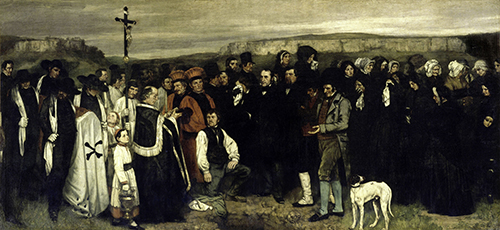 Painting by Gustave Courbet: A Burial At Ornans (French: Un enterrement à Ornans, also known as A Funeral At Ornans) represents one of the major turning points of 19th-century French art. The painting records the funeral in September 1848 of his great-uncle in the painter's birthplace, the small town of Ornans. It treats an ordinary provincial funeral with unflattering realism, and on the giant scale traditionally reserved for the heroic or religious scenes of history painting. Its exhibition at the 1850–51 Paris Salon created an "explosive reaction" and brought Courbet instant fame. It is currently displayed at the Musée d'Orsay in Paris, France.
Painting by Gustave Courbet: A Burial At Ornans (French: Un enterrement à Ornans, also known as A Funeral At Ornans) represents one of the major turning points of 19th-century French art. The painting records the funeral in September 1848 of his great-uncle in the painter's birthplace, the small town of Ornans. It treats an ordinary provincial funeral with unflattering realism, and on the giant scale traditionally reserved for the heroic or religious scenes of history painting. Its exhibition at the 1850–51 Paris Salon created an "explosive reaction" and brought Courbet instant fame. It is currently displayed at the Musée d'Orsay in Paris, France.
The Compromise of 1850 is introduced into Congress by Henry Clay as an omnibus bill designed to settle disputes arising from the conclusion of the Mexican War. It passes after Stephen Douglas divides the bill into several parts: California enters the Union as a free state; the slave trade (but not slavery) is abolished in Washington D.C.; the fugitive slave law is strengthened; and the Utah and New Mexico Territories are opened to slavery on the basis of popular sovereignty (allowing territorial voters to decide the issue without federa linterference).
 "Bibless overalls" made of canvas are sold by the 20 year-old Levi Strauss in San Francisco. Within three years he will switch to denim and dye his pants indigo blue.
"Bibless overalls" made of canvas are sold by the 20 year-old Levi Strauss in San Francisco. Within three years he will switch to denim and dye his pants indigo blue.
 German physicist Gustav Theodor Fechner discovers that an increase in the intensity of a stimulus does not produce a one-to-one increase in the intensity of sensation. Instead, the sensation seems to increase as the logarithm of the excitation.
German physicist Gustav Theodor Fechner discovers that an increase in the intensity of a stimulus does not produce a one-to-one increase in the intensity of sensation. Instead, the sensation seems to increase as the logarithm of the excitation.
 Mathematician Bernard Bolzano's Paradoxien des Unendlichen is published, two years after the Bolzano's death. It is the first work to use the word "set" in a modern mathematical sense, and also treats infinite sets.
Mathematician Bernard Bolzano's Paradoxien des Unendlichen is published, two years after the Bolzano's death. It is the first work to use the word "set" in a modern mathematical sense, and also treats infinite sets.
 In Über die bewegende Kraft der Wärme, mathematical physicist Rudolf Julius Emanuel Clausius articulates what comes to be known as the Second Law of Thermodynamics. The law states that heat can only be transferred from a warmer body to a colder body. In 1865, he'll restate the Law, saying that in the closed system entropy always increases.
In Über die bewegende Kraft der Wärme, mathematical physicist Rudolf Julius Emanuel Clausius articulates what comes to be known as the Second Law of Thermodynamics. The law states that heat can only be transferred from a warmer body to a colder body. In 1865, he'll restate the Law, saying that in the closed system entropy always increases.
 The fast-acting Collodion process invented by Frederick Scott Archer. Images require only two or three seconds of light exposure. Collodion process, mostly synonymous with the "collodion wet plate process", requires the photographic material to be coated, sensitized, exposed and developed within the span of about fifteen minutes, necessitating a portable darkroom for use in the field. Collodion is normally used in its wet form, but can also be used in humid ("preserved") or dry form, at the cost of greatly increased exposure time. The latter made the dry form unsuitable for the usual portraiture work of most professional photographers of the 19th century. The use of the dry form was therefore mostly confined to landscape photography and other special applications where minutes-long exposure times were tolerable.
The fast-acting Collodion process invented by Frederick Scott Archer. Images require only two or three seconds of light exposure. Collodion process, mostly synonymous with the "collodion wet plate process", requires the photographic material to be coated, sensitized, exposed and developed within the span of about fifteen minutes, necessitating a portable darkroom for use in the field. Collodion is normally used in its wet form, but can also be used in humid ("preserved") or dry form, at the cost of greatly increased exposure time. The latter made the dry form unsuitable for the usual portraiture work of most professional photographers of the 19th century. The use of the dry form was therefore mostly confined to landscape photography and other special applications where minutes-long exposure times were tolerable.
1851
 The New York Times begins daily publication. The editor of the Times is Henry J. Raymond.
The New York Times begins daily publication. The editor of the Times is Henry J. Raymond.
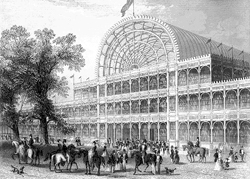 The Great Exhibition opens in London, housed at the Hyde Park Pavilion (the "Crystal Palace" designed by Joseph Paxton), on the First of May. It is the first world's fair, and is attended by more than 6 million people. London is the world's largest city, with a population of nearly 2.4 million people.
The Great Exhibition opens in London, housed at the Hyde Park Pavilion (the "Crystal Palace" designed by Joseph Paxton), on the First of May. It is the first world's fair, and is attended by more than 6 million people. London is the world's largest city, with a population of nearly 2.4 million people.
 Nathaniel Hawthorne's The House of the Seven Gables and The Snow Image and Other Twice-Told Tales both appear.
Nathaniel Hawthorne's The House of the Seven Gables and The Snow Image and Other Twice-Told Tales both appear.
 Moby Dick, by Herman Melville, is published.
Moby Dick, by Herman Melville, is published.
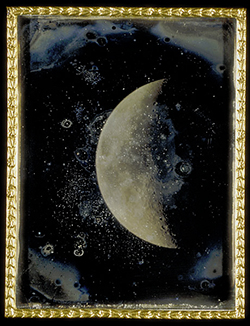 Daguerreotype by John Adams Whipple: Daguerreoype of the moon. Whipple was an American inventor and early photographer. He was the first in the United States to manufacture the chemicals used for daguerreotypes; he pioneered astronomical and night photography; he was a prize-winner for his extraordinary early photographs of the moon; and he was the first to produce images of stars other than the sun — the star Vega and the Mizar-Alcor stellar sextuple system, which was thought to be a double star until 2009.
Daguerreotype by John Adams Whipple: Daguerreoype of the moon. Whipple was an American inventor and early photographer. He was the first in the United States to manufacture the chemicals used for daguerreotypes; he pioneered astronomical and night photography; he was a prize-winner for his extraordinary early photographs of the moon; and he was the first to produce images of stars other than the sun — the star Vega and the Mizar-Alcor stellar sextuple system, which was thought to be a double star until 2009.
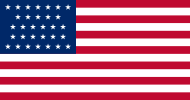 The US flag is modified to have thirty-one stars, reflecting the addition of one new state: California.
The US flag is modified to have thirty-one stars, reflecting the addition of one new state: California.
Arithmometer: first commercially successful mechanical calculator launched
 Isaac Singer patents the continuous-stitch sewing machine.
Isaac Singer patents the continuous-stitch sewing machine.
The Erie Railroad, now controlled by Daniel Drew, becomes the first rail line connecting the Great Lakes with New York City, and begins to compete with the Erie Canal as a transportation route.
 Mathematician Joseph Liouville demonstrates the existence of transcendental numbers (transcendentals are numbers that are not the solution to any algebraic equation).
Mathematician Joseph Liouville demonstrates the existence of transcendental numbers (transcendentals are numbers that are not the solution to any algebraic equation).
 Léon Foucault demonstrates that the Earth rotates using a pendulum, suspended from the ceiling of a church.
Léon Foucault demonstrates that the Earth rotates using a pendulum, suspended from the ceiling of a church.
 Physicist William Thomson proposes a concept of "absolute zero", at which the energy of molecules is zero. He draws on Charles' Law to show that such a condition would hold at -273 degrees Celsius.
Physicist William Thomson proposes a concept of "absolute zero", at which the energy of molecules is zero. He draws on Charles' Law to show that such a condition would hold at -273 degrees Celsius.
(no entry for this year)
1852
 Harriet Beecher Stowe publishes her anti-slavery novel, Uncle Tom's Cabin.
Harriet Beecher Stowe publishes her anti-slavery novel, Uncle Tom's Cabin.
 Peter Mark Roget publishes his Thesaurus of English Words and Phrases. Roget, a 73 year-old physician and English scholar, will publish 28 editions of the Thesaurus during his lifetime (he dies at age 90).
Peter Mark Roget publishes his Thesaurus of English Words and Phrases. Roget, a 73 year-old physician and English scholar, will publish 28 editions of the Thesaurus during his lifetime (he dies at age 90).
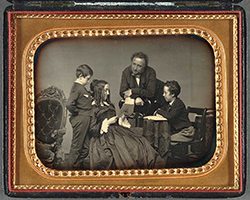 Daguerreotype by John Adams Whipple: Henry Winthrop Sargent and His Family. Whipple kept several distinctive pieces of furniture in his studio that he used to solidify his compositions by disposing them within an image in characteristic ways without having the sitter use them. In fact, it is this unique posing style that identifies Whipple as the artist of the portrait of Henry Winthrop Sargent and his family, taken in Boston in the early 1850s. Here, Whipple's composition is complex and masterful. The empty armchair at the lower left faces the viewer and draws the eye in. The covered table at the far right connects an occupied chair to the edge of the plate and suggests a vanishing point while giving diagonal movement to what is basically a horizontal composition. The corner of a plain backdrop, barely perceptible at the right, aids the illusion of movement and space. The empty armchair acts as a backrest for young Francis Sargent, who is actually supported by a posing stand, the base of which can be seen between his feet and his mother's skirts. Caroline Olmsted Sargent appears to be reading a letter to her assembled family. Her oldest son, Winthrop Henry Sargent, sits facing her, and their profiles echo across the space as he leans toward her. Henry Winthrop Sargent, at the apex of the composition, leans dynamically into the gathering, supporting his weight on the back of a carved side chair. The division of the family into two pairs of linked figures creates powerful parallel diagonals; but despite this calculated arrangement, all of the sitters appear to be at ease and engaged with one another.
Daguerreotype by John Adams Whipple: Henry Winthrop Sargent and His Family. Whipple kept several distinctive pieces of furniture in his studio that he used to solidify his compositions by disposing them within an image in characteristic ways without having the sitter use them. In fact, it is this unique posing style that identifies Whipple as the artist of the portrait of Henry Winthrop Sargent and his family, taken in Boston in the early 1850s. Here, Whipple's composition is complex and masterful. The empty armchair at the lower left faces the viewer and draws the eye in. The covered table at the far right connects an occupied chair to the edge of the plate and suggests a vanishing point while giving diagonal movement to what is basically a horizontal composition. The corner of a plain backdrop, barely perceptible at the right, aids the illusion of movement and space. The empty armchair acts as a backrest for young Francis Sargent, who is actually supported by a posing stand, the base of which can be seen between his feet and his mother's skirts. Caroline Olmsted Sargent appears to be reading a letter to her assembled family. Her oldest son, Winthrop Henry Sargent, sits facing her, and their profiles echo across the space as he leans toward her. Henry Winthrop Sargent, at the apex of the composition, leans dynamically into the gathering, supporting his weight on the back of a carved side chair. The division of the family into two pairs of linked figures creates powerful parallel diagonals; but despite this calculated arrangement, all of the sitters appear to be at ease and engaged with one another.
In South Bend, Indiana, Clement and Henry Studebaker found Studebaker Brothers. Joined by a third brother, John, in 1858, the company will become the world's largest maker of wagons and carriages.
 In Sweden, safety matches are patented by J. E. Lundstrom.
In Sweden, safety matches are patented by J. E. Lundstrom.
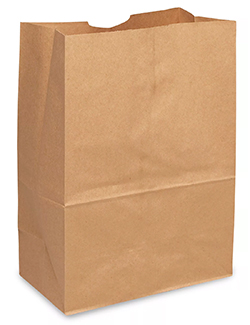 The brown paper bag is invented.
The brown paper bag is invented.
The elevator is invented, facilitating the future development of skyscrapers.
The U.S. state of Pennsylvania adopts a non-standard railroad gauge in order to prevent New York's Erie Railroad from establishing a route, through Pennsylvania, to Ohio.
 The French Republic falls; Louis Napoleon (Napoleon III) is crowned Emperor.
The French Republic falls; Louis Napoleon (Napoleon III) is crowned Emperor.
The U.S. state of Massachusetts adopts a compulsory school-attendance law, the first effective example of such a law in the nation.
 Albrecht von Kölliker publishes the first textbook of histology, Handbuch der Gewebelehre.
Albrecht von Kölliker publishes the first textbook of histology, Handbuch der Gewebelehre.
 Hermann Ludwig von Helmholtz becomes the first to discover how fast a message travels along a nerve, measuring the speed of transmission in a frog nerve cell.
Hermann Ludwig von Helmholtz becomes the first to discover how fast a message travels along a nerve, measuring the speed of transmission in a frog nerve cell.

 James Prescott Joule and William Thompson, later Lord Kelvin, establish that an expanding gas becomes cooler. This is now known as the Joule-Thompson effect.
James Prescott Joule and William Thompson, later Lord Kelvin, establish that an expanding gas becomes cooler. This is now known as the Joule-Thompson effect.
(no entry for this year)
1853
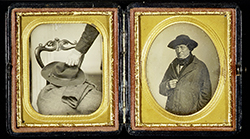 Daguerreotype by John Adams Whipple: Cornelius Conway Felton with His Hat and Coat. Felton was Eliot Professor of Greek Literature at Harvard University, reaching for his felt hat and duster. The first son of a poverty-stricken furniture maker, Felton became one of the most renowned classical scholars in the country and, in 1860, Harvard's president. This witty photograph lampoons the rigid formality of the portrait process through narrative gesture (the implied reach across two separate images) and nuance (the delicate crush of the soft hat's crown). As opposed to the inflexible silk top hat worn by dandies and professors alike, the broad-brimmed felt hat was worn by outdoorsmen and was practical, casual, and fundamentally democratic.
Daguerreotype by John Adams Whipple: Cornelius Conway Felton with His Hat and Coat. Felton was Eliot Professor of Greek Literature at Harvard University, reaching for his felt hat and duster. The first son of a poverty-stricken furniture maker, Felton became one of the most renowned classical scholars in the country and, in 1860, Harvard's president. This witty photograph lampoons the rigid formality of the portrait process through narrative gesture (the implied reach across two separate images) and nuance (the delicate crush of the soft hat's crown). As opposed to the inflexible silk top hat worn by dandies and professors alike, the broad-brimmed felt hat was worn by outdoorsmen and was practical, casual, and fundamentally democratic.
 Commodore Matthew Perry sails into Japan's Edo Bay with his black ships (four modern, steam-powered warships), urging Japan to open trade policies with the United States.
Commodore Matthew Perry sails into Japan's Edo Bay with his black ships (four modern, steam-powered warships), urging Japan to open trade policies with the United States.
 Franklin Pierce becomes fourteenth president of the United States.
Franklin Pierce becomes fourteenth president of the United States.
 Rudolph Albert von Kölliker discovers the cellular origin of spermatozoa, which were believed by some to originate from a fermentation process.
Rudolph Albert von Kölliker discovers the cellular origin of spermatozoa, which were believed by some to originate from a fermentation process.
In Britain, vaccination against small pox is made compulsory.
 Léon Foucault demonstrates that the velocity of light is lesson water than in air, tending to confirm the wave theory of light.
Léon Foucault demonstrates that the velocity of light is lesson water than in air, tending to confirm the wave theory of light.
 William John Macquorn Rankine introduces the concept of potential energy, or energy of position.
William John Macquorn Rankine introduces the concept of potential energy, or energy of position.
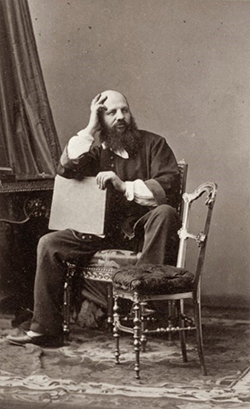 André-Adolphe-Eugène Disdéri credited with introduction of the carte de visite (English: visiting card or calling card) format for portraiture. Disdéri uses a camera with multiple lenses that can photograph eight different poses on one large negative. After printing on albumen paper, the images are cut apart and glued to calling-card-size mounts. Photographs had previously served as calling cards, but Disdéri's invention of the paper carte de visite (i.e. "visiting card") enabled the mass production of photographs. On 27 November 1854 he patented the system of printing ten photographs on a single sheet (although there is no evidence that a system printing more than eight actually materialized). Disdéri's's cartes de visite were 6×9 cm, about the size of conventional (nonphotographic) visiting cards of the time, and were made by a camera with four lenses and a sliding plate holder; a design inspired by the stereoscopic cameras. The novelty quickly spread throughout the world. According to a German visitor, Disdéri's studio became "really the Temple of Photography - a place unique in its luxury and elegance. Daily he sells three to four thousand francs worth of portraits". The fact that these photos could be reproduced inexpensively and in great quantity brought about the decline of the daguerreotype and ushered in a carte de visite craze as they became enormously popular throughout Europe and the United States. Disdéri also invented the twin-lens reflex camera.
André-Adolphe-Eugène Disdéri credited with introduction of the carte de visite (English: visiting card or calling card) format for portraiture. Disdéri uses a camera with multiple lenses that can photograph eight different poses on one large negative. After printing on albumen paper, the images are cut apart and glued to calling-card-size mounts. Photographs had previously served as calling cards, but Disdéri's invention of the paper carte de visite (i.e. "visiting card") enabled the mass production of photographs. On 27 November 1854 he patented the system of printing ten photographs on a single sheet (although there is no evidence that a system printing more than eight actually materialized). Disdéri's's cartes de visite were 6×9 cm, about the size of conventional (nonphotographic) visiting cards of the time, and were made by a camera with four lenses and a sliding plate holder; a design inspired by the stereoscopic cameras. The novelty quickly spread throughout the world. According to a German visitor, Disdéri's studio became "really the Temple of Photography - a place unique in its luxury and elegance. Daily he sells three to four thousand francs worth of portraits". The fact that these photos could be reproduced inexpensively and in great quantity brought about the decline of the daguerreotype and ushered in a carte de visite craze as they became enormously popular throughout Europe and the United States. Disdéri also invented the twin-lens reflex camera.
1854
 Henry David Thoreau's Walden, or Life in the Woods is published.
Henry David Thoreau's Walden, or Life in the Woods is published.
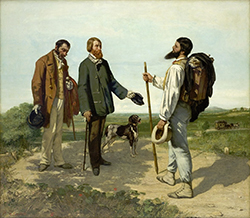 Painting by Gustave Courbet: The Meeting (French: La rencontre) is traditionally interpreted as Courbet greeted by his patron Alfred Bruyas, his servant Calas, and his dog while traveling to Montpellier. The composition is based on the Wandering Jew. The Meeting was exhibited in Paris at the 1855 Exhibition Universelle, where critics ridiculed it as "Bonjour, Monsieur Courbet". Bruyas did not exhibit The Meeting until he donated it to the Musée Fabre in Montpellier in 1868.
Painting by Gustave Courbet: The Meeting (French: La rencontre) is traditionally interpreted as Courbet greeted by his patron Alfred Bruyas, his servant Calas, and his dog while traveling to Montpellier. The composition is based on the Wandering Jew. The Meeting was exhibited in Paris at the 1855 Exhibition Universelle, where critics ridiculed it as "Bonjour, Monsieur Courbet". Bruyas did not exhibit The Meeting until he donated it to the Musée Fabre in Montpellier in 1868.
Kansas-Nebraska Act: In an attempt to spur population growth in the western territories in advance of a transcontinental railroad, Stephen Douglas introduces a bill to establish the territories of Kansas and Nebraska. In order to gain Southern support, the bill stipulates that slavery in the territories will be decided by popular sovereignty. Thus the Kansas-Nebraska Act repeals the Missouri Compromise ban on slavery north of 36 30' in the lands of the Louisiana Purchase.
Ostend Manifesto: The U.S. ministers to Britain, France, and Spain meet in Ostend, Belgium. They draft a policy recommendation to President Pierce, urging him to attempt again to purchase Cuba from Spain and, if Spain refuses, to take the island by force. When the secret proposal, called the Ostend Manifesto, is leaked to the press, it creates an uproar since Cuba would likely become another slave state.
 On May 24, Virginia fugitive slave Anthony Burns is captured in Boston and returned to slavery under the provisions of the Fugitive Slave Act. Fifty thousand Boston residents watch his transport through the streets of the city in shackles. A Boston church raises $1500 to purchase his freedom and Burns returns to the city in 1855, a free man.
On May 24, Virginia fugitive slave Anthony Burns is captured in Boston and returned to slavery under the provisions of the Fugitive Slave Act. Fifty thousand Boston residents watch his transport through the streets of the city in shackles. A Boston church raises $1500 to purchase his freedom and Burns returns to the city in 1855, a free man.
On May 30, the Kansas-Nebraska act is passed by Congress. The act repeals the Missouri Compromise and permits the admission of Kansas and Nebraska territories to the Union after their white male voters decide the fate of slavery in those territories.
Slavery is abolished in Peru and Venezuela.
The Republican Party is formed in the summer in opposition to the extension of slavery into the western territories.
 Mathematician George Boole, whose "Calculus of Logic," appeared in 1848, publishes An Investigation of the Laws of Thought, on Which are Founded the Mathematical Theories of Logic and Probabilities, which articulates a system of "symbolic logic".
Mathematician George Boole, whose "Calculus of Logic," appeared in 1848, publishes An Investigation of the Laws of Thought, on Which are Founded the Mathematical Theories of Logic and Probabilities, which articulates a system of "symbolic logic".
(no entry for this year)
1855
 In Watertown, Wisconsin, the first kindergarten in the U.S. is opened by Mrs. Carl Schurz (Margarethe Meyer Schurz).
In Watertown, Wisconsin, the first kindergarten in the U.S. is opened by Mrs. Carl Schurz (Margarethe Meyer Schurz).
 Henry Wadsworth Longfellow's "Song of Hiawatha" appears.
Henry Wadsworth Longfellow's "Song of Hiawatha" appears.
 Poet Walt Whitman publishes a volume of twelve poems, Leaves of Grass, at his own expense, and meets with no commercial success.
Poet Walt Whitman publishes a volume of twelve poems, Leaves of Grass, at his own expense, and meets with no commercial success.
The Massachusetts Legislature outlaws racially segregated schools.

 A mercury pump is developed by inventor Heinrich Geissler, to produce vacuum tubes. The first cathode rays will be observed in these tubes, after they are modified and improved by Sir William Crookes.
A mercury pump is developed by inventor Heinrich Geissler, to produce vacuum tubes. The first cathode rays will be observed in these tubes, after they are modified and improved by Sir William Crookes.
 Engineer Frederick Taylor carries out "time-motion" studies of workers with the idea of making their labor more efficient. He will pioneer the "scientific management" of the workplace.
Engineer Frederick Taylor carries out "time-motion" studies of workers with the idea of making their labor more efficient. He will pioneer the "scientific management" of the workplace.
 Alfred Russel Wallace publishes "On the Law which has Regulated the Introduction of New Species," anticipating Darwin's theory of evolution by natural selection.
Alfred Russel Wallace publishes "On the Law which has Regulated the Introduction of New Species," anticipating Darwin's theory of evolution by natural selection.
 Rudolf Virchow states the principle that new cells come into being only by division of previously existing cells: Omnis cellula e cellula.
Rudolf Virchow states the principle that new cells come into being only by division of previously existing cells: Omnis cellula e cellula.
 Recherches sur la putréfaction, by Louis Pasteur, is published. The book describes how fermentation is caused by microorganisms.
Recherches sur la putréfaction, by Louis Pasteur, is published. The book describes how fermentation is caused by microorganisms.
(no entry for this year)
1856
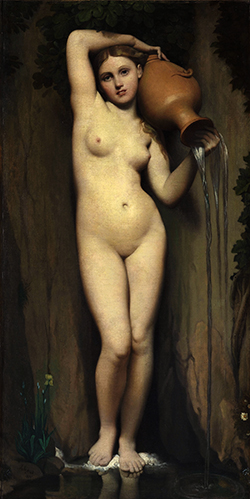 Painting by Jean Auguste Dominique Ingres: The Source (French: La Source), was begun in Florence around 1820 and not completed until 1856, in Paris. When Ingres completed The Source, he was seventy-six years old, already famous, and president of the cole des Beaux-Arts. The pose of the nude may be compared with that of another by Ingres, the Venus Anadyomene (1848), and is a reimagination of the Aphrodite of Cnidus or Venus Pudica. Two of Ingres' students, painters Paul Balze and Alexandre Desgoffe, helped to create the background and water jar. The first exhibition of The Source was in 1856, the year it was completed. The painting was received enthusiastically. Duch tel acquired the painting in 1857 for a sum of 25,000 francs. The state assumed title to the painting in 1878 and it passed to the Mus e du Louvre. In 1986 it was transferred to the Mus e d'Orsay. The painting has been frequently exhibited and widely published. Haldane Macfall in A History of Painting: The French Genius describes The Source as Ingres' "superb nude by which he is chiefly known". Kenneth Clark in his book Feminine Beauty observed how The Source has been described as "the most beautiful figure in French painting."
Painting by Jean Auguste Dominique Ingres: The Source (French: La Source), was begun in Florence around 1820 and not completed until 1856, in Paris. When Ingres completed The Source, he was seventy-six years old, already famous, and president of the cole des Beaux-Arts. The pose of the nude may be compared with that of another by Ingres, the Venus Anadyomene (1848), and is a reimagination of the Aphrodite of Cnidus or Venus Pudica. Two of Ingres' students, painters Paul Balze and Alexandre Desgoffe, helped to create the background and water jar. The first exhibition of The Source was in 1856, the year it was completed. The painting was received enthusiastically. Duch tel acquired the painting in 1857 for a sum of 25,000 francs. The state assumed title to the painting in 1878 and it passed to the Mus e du Louvre. In 1986 it was transferred to the Mus e d'Orsay. The painting has been frequently exhibited and widely published. Haldane Macfall in A History of Painting: The French Genius describes The Source as Ingres' "superb nude by which he is chiefly known". Kenneth Clark in his book Feminine Beauty observed how The Source has been described as "the most beautiful figure in French painting."
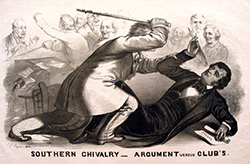 The Caning of Charles Sumner: Senator Charles Sumner delivers a stinging speech in the U.S. Senate, "The Crime against Kansas," in which he attacks slavery, the South, and singles out his Senate colleague, Andrew Butler of South Carolina, for criticism. In retaliation, Butler's nephew, Congressman Preston Brooks of South Carolina, attacks Sumner with a cane while the Massachusetts senator is seated at his desk on the floor of the Senate. The injuries he sustains cause Sumner to be absent from the Senate for four years. The episode revealed the polarization in America, as Sumner became a martyr in the North and Brooks a hero in the South. Northerners were outraged. Southerners sent Brooks hundreds of new canes in endorsement of his assault. One was inscribed "Hit him again." Brooks claimed that he had not intended to kill Sumner, or else he would have used a different weapon. In a speech to the House defending his actions, Brooks stated that he "meant no disrespect to the Senate of the United States" or the House by his attack on Sumner. He was tried in a District of Columbia court, convicted for assault, and fined $300 ($8,000 in today's dollars), but received no prison sentence.
The Caning of Charles Sumner: Senator Charles Sumner delivers a stinging speech in the U.S. Senate, "The Crime against Kansas," in which he attacks slavery, the South, and singles out his Senate colleague, Andrew Butler of South Carolina, for criticism. In retaliation, Butler's nephew, Congressman Preston Brooks of South Carolina, attacks Sumner with a cane while the Massachusetts senator is seated at his desk on the floor of the Senate. The injuries he sustains cause Sumner to be absent from the Senate for four years. The episode revealed the polarization in America, as Sumner became a martyr in the North and Brooks a hero in the South. Northerners were outraged. Southerners sent Brooks hundreds of new canes in endorsement of his assault. One was inscribed "Hit him again." Brooks claimed that he had not intended to kill Sumner, or else he would have used a different weapon. In a speech to the House defending his actions, Brooks stated that he "meant no disrespect to the Senate of the United States" or the House by his attack on Sumner. He was tried in a District of Columbia court, convicted for assault, and fined $300 ($8,000 in today's dollars), but received no prison sentence.
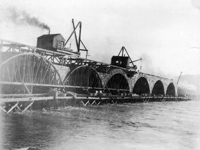 A railway bridge spanning the Mississippi opens between Rockville, Illinois, and Davenport, Iowa. Abraham Lincoln, a lawyer, will defend the legality of the bridge before the Supreme Court, in response to a "right of way" suit brought by a steamship company.
A railway bridge spanning the Mississippi opens between Rockville, Illinois, and Davenport, Iowa. Abraham Lincoln, a lawyer, will defend the legality of the bridge before the Supreme Court, in response to a "right of way" suit brought by a steamship company.
 During Easter vacation from London's Royal College of Chemistry, 18-year-old William Henry Perkin synthesized mauve, or aniline purple — the first synthetic dyestuff — from chemicals derived from coal tar. Mauve was enthusiastically adopted by the fashion industry in England and synthetic dyes quickly destroyed the market for natural substances derived from plants like indigo and madder. Perkin's creation was an accident — he was trying to synthesize quinine.
During Easter vacation from London's Royal College of Chemistry, 18-year-old William Henry Perkin synthesized mauve, or aniline purple — the first synthetic dyestuff — from chemicals derived from coal tar. Mauve was enthusiastically adopted by the fashion industry in England and synthetic dyes quickly destroyed the market for natural substances derived from plants like indigo and madder. Perkin's creation was an accident — he was trying to synthesize quinine.
 The "Bessemer process" for making inexpensive steel, which involves using blasts of cold air to decarbonize melted pig iron, is developed by inventor Henry Bessemer.
The "Bessemer process" for making inexpensive steel, which involves using blasts of cold air to decarbonize melted pig iron, is developed by inventor Henry Bessemer.
The 458-mile Wabash and Erie Canal opens after 24 years, and is the largest canal ever dug in the U.S. By 1860, however, sections will begin to be close, and, unable to compete for railroads, the entire Canal will be closed by 1874.
In South Africa, Boers establish the South African Republic (Transvaal), with Pretoria as its capital. Marthinus Wessels Pretorius, 37, is named the first president.
The Second Opium War (1856-1860) between Britain and China leads to further erosion of Chinese sovereignty.
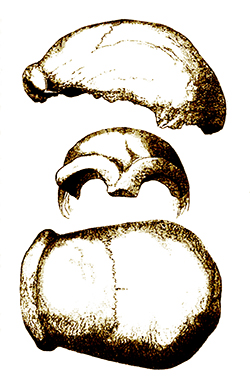 The remains of the first known example of what come to be known as the "Neanderthals" is found in a cave near Düsseldorf, in the Neander Valley. The discovery was made by limestone quarry miners and consists of a skullcap, two femora, the three right arm bones, two of the left arm bones, ilium, and fragments of a scapula and ribs. The fossils were given to Johann Carl Fuhlrott, a local teacher and amateur naturalist. The first description of the remains was made by anatomist Hermann Schaaffhausen and the find was announced jointly in 1857.In 1997, the specimen was the first to yield Neanderthal mitochondrial DNA fragments. The description of this discovery represents the beginning of paleoanthropology as a scientific discipline.
The remains of the first known example of what come to be known as the "Neanderthals" is found in a cave near Düsseldorf, in the Neander Valley. The discovery was made by limestone quarry miners and consists of a skullcap, two femora, the three right arm bones, two of the left arm bones, ilium, and fragments of a scapula and ribs. The fossils were given to Johann Carl Fuhlrott, a local teacher and amateur naturalist. The first description of the remains was made by anatomist Hermann Schaaffhausen and the find was announced jointly in 1857.In 1997, the specimen was the first to yield Neanderthal mitochondrial DNA fragments. The description of this discovery represents the beginning of paleoanthropology as a scientific discipline.
Louis Agassiz publishes Essay on Classification advocating a theory of multiple creations and contradicting both evolution and Noah's ark.
 Gregor Mendel, a monk at the Augustinian monastery of St. Thomas in Brünn, Austria (now Brno, Czechoslovakia), begins breeding experiments with the garden pea, Pisum sativum.
Gregor Mendel, a monk at the Augustinian monastery of St. Thomas in Brünn, Austria (now Brno, Czechoslovakia), begins breeding experiments with the garden pea, Pisum sativum.
Heinz Christian Pander describes conodonts — toothy microfossils that will puzzle paleontologists for many years.
(no entry for this year)
1857
 Madame Bovery, by Gustave Flaubert, is published
Madame Bovery, by Gustave Flaubert, is published
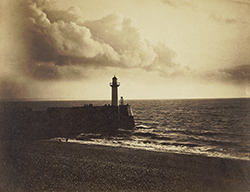 Photograph by Gustave Le Gray: Lighthouse and Jetty, le Havre, an albumen print.
Photograph by Gustave Le Gray: Lighthouse and Jetty, le Havre, an albumen print.
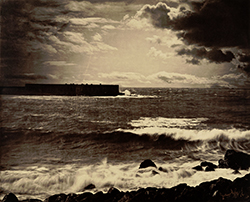 Photograph by Gustave Le Gray: The Great Wave. The dramatic effects of sunlight, clouds, and water in Le Gray's seascapes stunned his contemporaries and immediately brought him international recognition. At a time when photographic emulsions were not equally sensitive to all colors of the spectrum, most photographers found it impossible to achieve proper exposure of both landscape and sky in a single picture. Le Gray solved this problem by printing two negatives on a single sheet of paper: one exposed for the sea, the other for the sky, and sometimes made on separate occasions or in different locations. Le Gray's marine pictures caused a sensation not only because their simultaneous depiction of sea and heavens represented a technical tour de force, but also because the resulting poetic effect was without precedent in photography.
Photograph by Gustave Le Gray: The Great Wave. The dramatic effects of sunlight, clouds, and water in Le Gray's seascapes stunned his contemporaries and immediately brought him international recognition. At a time when photographic emulsions were not equally sensitive to all colors of the spectrum, most photographers found it impossible to achieve proper exposure of both landscape and sky in a single picture. Le Gray solved this problem by printing two negatives on a single sheet of paper: one exposed for the sea, the other for the sky, and sometimes made on separate occasions or in different locations. Le Gray's marine pictures caused a sensation not only because their simultaneous depiction of sea and heavens represented a technical tour de force, but also because the resulting poetic effect was without precedent in photography.
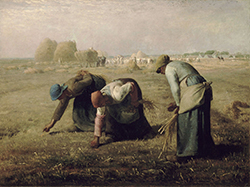 Painting by Jean-François Millet: The Gleaners (Des glaneuses) depicts three peasant women gleaning a field of stray grains of wheat after the harvest. The painting is famous for featuring in a sympathetic way what were then the lowest ranks of rural society; this was received poorly by the French upper classes. The painting immediately drew negative criticism from the middle and upper classes, who viewed the topic with suspicion: one art critic, speaking for other Parisians, perceived in it an alarming intimation of "the scaffolds of 1793." Its size (33×44 inches) was also considered offensive, as it was too large for an image depicting mere labor.
Painting by Jean-François Millet: The Gleaners (Des glaneuses) depicts three peasant women gleaning a field of stray grains of wheat after the harvest. The painting is famous for featuring in a sympathetic way what were then the lowest ranks of rural society; this was received poorly by the French upper classes. The painting immediately drew negative criticism from the middle and upper classes, who viewed the topic with suspicion: one art critic, speaking for other Parisians, perceived in it an alarming intimation of "the scaffolds of 1793." Its size (33×44 inches) was also considered offensive, as it was too large for an image depicting mere labor.
 Farmer Hinton Rowan Helper publishes The Impending Crisis of the South, and How to Meet It, in which he argues that slavery in economically unwise, and particularly devastating to small farmers who do not own slaves. He writes that slavery is "the root of all the shame, poverty, ignorance, tyranny and imbecility" in the South. He also argues that slavery foolishly ties up economic resources in human beings when it might be spent on labor-saving improvements.
Farmer Hinton Rowan Helper publishes The Impending Crisis of the South, and How to Meet It, in which he argues that slavery in economically unwise, and particularly devastating to small farmers who do not own slaves. He writes that slavery is "the root of all the shame, poverty, ignorance, tyranny and imbecility" in the South. He also argues that slavery foolishly ties up economic resources in human beings when it might be spent on labor-saving improvements.
The African slave trade is prohibited in the Ottoman Empire
 The Dred Scott Decision makes the Missouri Compromise unconstitutional and increases tension between North and South over slavery in the United States. Writing for the majority, Chief Justice Roger B. Taney asserted that blacks were "beings of an inferior order, and altogether unfit to associate with the white race, either in social or political relations, and so far inferior that they had no rights which the white man was bound to respect." This embarrassing decision represents a low point in the history of the United States Supreme Court.
The Dred Scott Decision makes the Missouri Compromise unconstitutional and increases tension between North and South over slavery in the United States. Writing for the majority, Chief Justice Roger B. Taney asserted that blacks were "beings of an inferior order, and altogether unfit to associate with the white race, either in social or political relations, and so far inferior that they had no rights which the white man was bound to respect." This embarrassing decision represents a low point in the history of the United States Supreme Court.
 In Burrville, Connecticut, commercial production of Gail Borden's patented "condensed milk" begins. The product is made from skim milk, without any fat and without a number of nutrients found in cow's milk.
In Burrville, Connecticut, commercial production of Gail Borden's patented "condensed milk" begins. The product is made from skim milk, without any fat and without a number of nutrients found in cow's milk.
In California, Tokay, Zinfandel, and Shiraz grapes (all from Hungary) are first planted, and Italian honeybees are introduced. This is the beginning of the U.S. wine and honey industries. In North America, honey bees are an artificially introduced and invasive species.
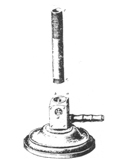 Robert Wilhelm von Bunsen (along with Henry Roscoe) publish a design for a laboratory burner in Poggendorff's Annalen der Physik und Chemie, 100:84-85.
Robert Wilhelm von Bunsen (along with Henry Roscoe) publish a design for a laboratory burner in Poggendorff's Annalen der Physik und Chemie, 100:84-85.
 James Buchanan becomes fifteenth president of the United States.
James Buchanan becomes fifteenth president of the United States.
 Giuseppe Garibaldi, who returned to Italy in 1854 after several years working at Staten Island, New York, founds the Italian National Association. The organization is designed to promote the unification of Italy.
Giuseppe Garibaldi, who returned to Italy in 1854 after several years working at Staten Island, New York, founds the Italian National Association. The organization is designed to promote the unification of Italy.
 Über die Art der Bewegung, welche wir Wäe nennen (On the type of motion turned heat) by Rudolf Clausius is establishes his kinetic theory of heat of the mathematical basis. It also explains how evaporation occurs.
Über die Art der Bewegung, welche wir Wäe nennen (On the type of motion turned heat) by Rudolf Clausius is establishes his kinetic theory of heat of the mathematical basis. It also explains how evaporation occurs.
(no entry for this year)
1858
Central Park, in New York City, is opened to the public.
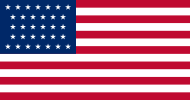 The US flag is modified to have thirty-two stars, reflecting the addition of one new state: Minnesota.
The US flag is modified to have thirty-two stars, reflecting the addition of one new state: Minnesota.
J. Schweppe & Co. Ltd. patents a quinine tonic water that they will begin selling in 1880.
 John Landis Mason patents a reusable glass jar.
John Landis Mason patents a reusable glass jar.
 Abraham Lincoln, running for the United States Senate, declares "A house divided against itself cannot stand." He loses the race to Stephen Douglas, but his performance in there now-legendary debates leads to his nomination as the Republican candidate for president in 1860.
Abraham Lincoln, running for the United States Senate, declares "A house divided against itself cannot stand." He loses the race to Stephen Douglas, but his performance in there now-legendary debates leads to his nomination as the Republican candidate for president in 1860.
In Ireland, the group Sein Féin is founded.
Rudolf Virchow finalizes the cell theory originally announced by Schleiden and Schwann 11 years earlier by declaring that cells are the basic units of all living things, and all cells are formed by the division of existing cells.
 Alfred Russel Wallace sends to Darwin a manuscript — "On the Tendency of Varieties to Depart Indefinitely from the Original Type" — that shows clearly that Wallace has independently formulated a model of evolution by natural selection.
Alfred Russel Wallace sends to Darwin a manuscript — "On the Tendency of Varieties to Depart Indefinitely from the Original Type" — that shows clearly that Wallace has independently formulated a model of evolution by natural selection.

 Darwin's and Wallace's ideas are jointly presented to the Linnaean Society of London.
Darwin's and Wallace's ideas are jointly presented to the Linnaean Society of London.
The first relatively complete dinosaur skeleton, of Hadrosaurus foulkii, is found in New Jersey.
 Physician Henry Gray publishes Anatomy of the Human Body, Descriptive and Surgical. Gray's Anatomy will be a standard textbook of anatomy for more than a century.
Physician Henry Gray publishes Anatomy of the Human Body, Descriptive and Surgical. Gray's Anatomy will be a standard textbook of anatomy for more than a century.
 The concept of "bonds" is introduced by chemist Archibald Scott Couper, who believes that carbon atoms are the fundamental building blocks of organic compounds.
The concept of "bonds" is introduced by chemist Archibald Scott Couper, who believes that carbon atoms are the fundamental building blocks of organic compounds.
 Julius Plücker shows that cathode rays bend under the influence of a magnet, suggesting they are connected in some way with charge. This is an early step along the path that will lead in 1897 to the discovery that cathode rays are composed of electrons.
Julius Plücker shows that cathode rays bend under the influence of a magnet, suggesting they are connected in some way with charge. This is an early step along the path that will lead in 1897 to the discovery that cathode rays are composed of electrons.
(no entry for this year)
1859
In Manchester, England, the first "playgrounds" for children are opened, complete with swings and horizontal bars for climbing and hanging.
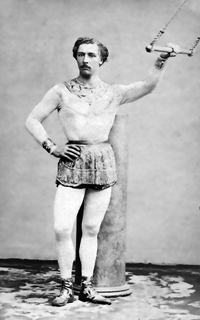 Jules Léotard performs the first flying trapeze circus act, with the Cirque Napoléon in Paris. Léotard's standard performance costume — a skin-tight one-piece garment that covers the torso but leaves the legs free — later becomes known generically as a "leotard." Léotard also becomes the subject of a popular song: "The Daring Young Man on the Flying Trapeze."
Jules Léotard performs the first flying trapeze circus act, with the Cirque Napoléon in Paris. Léotard's standard performance costume — a skin-tight one-piece garment that covers the torso but leaves the legs free — later becomes known generically as a "leotard." Léotard also becomes the subject of a popular song: "The Daring Young Man on the Flying Trapeze."
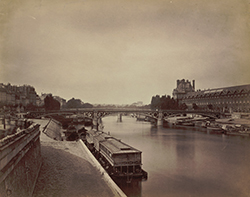 Photograph by Gustave Le Gray: The Pont du Carrousel Seen from the Pont Royal, an albumen print.
Photograph by Gustave Le Gray: The Pont du Carrousel Seen from the Pont Royal, an albumen print.
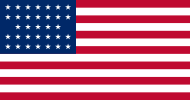 The US flag is modified to have thirty-three stars, reflecting the addition of one new state: Oregon.
The US flag is modified to have thirty-three stars, reflecting the addition of one new state: Oregon.
Harriet Wilson of Milford, New Hampshire, publishes Our Nig; or Sketches from the Life of a Free Black, the first novel by an African-American woman.
 On October 16, John Brown leads 20 men, including five African-Americans, in an unsuccessful attempt to seize the Federal Armory at Harper's ferry, Virginia, with the goal of inspiring a slave insurrection. He was captured by US troops under the command of Colonel Robert E. Lee, tried, and hanged on December 2.
On October 16, John Brown leads 20 men, including five African-Americans, in an unsuccessful attempt to seize the Federal Armory at Harper's ferry, Virginia, with the goal of inspiring a slave insurrection. He was captured by US troops under the command of Colonel Robert E. Lee, tried, and hanged on December 2.
 In Titusville, Pennsylvania, commercial production of petroleum begins, with drilling of the first well by Edwin Laurentine Drake. The well will produce approximately 400 gallons/day.
In Titusville, Pennsylvania, commercial production of petroleum begins, with drilling of the first well by Edwin Laurentine Drake. The well will produce approximately 400 gallons/day.
 The first internal combustion engine is developed by Jean-Joseph-Etienne Lenoir. The engine uses coal gas.
The first internal combustion engine is developed by Jean-Joseph-Etienne Lenoir. The engine uses coal gas.
 Charles Darwin publishes On the Origin of Species.
Charles Darwin publishes On the Origin of Species.
An exceptionally well-preserved skeleton is discovered in Bavaria. Two years later, this bird-like, bipedal dinosaur will be named Compsognathus, meaning "dainty jaw."
Catholic priest Jean-Jacques Pouech describes fossil eggshell fragments. They will eventually prove to be the first described dinosaur eggs.
 Matrix algebra begins, as mathematician Arthur Cayley discusses the matrix in the context of a theory of invariant transformations.
Matrix algebra begins, as mathematician Arthur Cayley discusses the matrix in the context of a theory of invariant transformations.
 Gustav Kirchoff recognizes that sodium is found on the sun and discovers his black-body radiation law.
Gustav Kirchoff recognizes that sodium is found on the sun and discovers his black-body radiation law.

 Physicist Gustav Robert Kirchhoff and chemist R. W. Bunsen explain that when light passes through a gas, or heated material, only certain wavelengths of the light are absorbed. Therefore, an analysis of the spectrum of the light can reveal the chemical makeup of the gas or material.
Physicist Gustav Robert Kirchhoff and chemist R. W. Bunsen explain that when light passes through a gas, or heated material, only certain wavelengths of the light are absorbed. Therefore, an analysis of the spectrum of the light can reveal the chemical makeup of the gas or material.
ESP Quick Facts
ESP Origins
In the early 1990's, Robert Robbins was a faculty member at Johns Hopkins, where he directed the informatics core of GDB — the human gene-mapping database of the international human genome project. To share papers with colleagues around the world, he set up a small paper-sharing section on his personal web page. This small project evolved into The Electronic Scholarly Publishing Project.
ESP Support
In 1995, Robbins became the VP/IT of the Fred Hutchinson Cancer Research Center in Seattle, WA. Soon after arriving in Seattle, Robbins secured funding, through the ELSI component of the US Human Genome Project, to create the original ESP.ORG web site, with the formal goal of providing free, world-wide access to the literature of classical genetics.
ESP Rationale
Although the methods of molecular biology can seem almost magical to the uninitiated, the original techniques of classical genetics are readily appreciated by one and all: cross individuals that differ in some inherited trait, collect all of the progeny, score their attributes, and propose mechanisms to explain the patterns of inheritance observed.
ESP Goal
In reading the early works of classical genetics, one is drawn, almost inexorably, into ever more complex models, until molecular explanations begin to seem both necessary and natural. At that point, the tools for understanding genome research are at hand. Assisting readers reach this point was the original goal of The Electronic Scholarly Publishing Project.
ESP Usage
Usage of the site grew rapidly and has remained high. Faculty began to use the site for their assigned readings. Other on-line publishers, ranging from The New York Times to Nature referenced ESP materials in their own publications. Nobel laureates (e.g., Joshua Lederberg) regularly used the site and even wrote to suggest changes and improvements.
ESP Content
When the site began, no journals were making their early content available in digital format. As a result, ESP was obliged to digitize classic literature before it could be made available. For many important papers — such as Mendel's original paper or the first genetic map — ESP had to produce entirely new typeset versions of the works, if they were to be available in a high-quality format.
ESP Help
Early support from the DOE component of the Human Genome Project was critically important for getting the ESP project on a firm foundation. Since that funding ended (nearly 20 years ago), the project has been operated as a purely volunteer effort. Anyone wishing to assist in these efforts should send an email to Robbins.
ESP Plans
With the development of methods for adding typeset side notes to PDF files, the ESP project now plans to add annotated versions of some classical papers to its holdings. We also plan to add new reference and pedagogical material. We have already started providing regularly updated, comprehensive bibliographies to the ESP.ORG site.
ESP Picks from Around the Web (updated 06 MAR 2017 )
Old Science

Weird Science

Treating Disease with Fecal Transplantation
Fossils of miniature humans (hobbits) discovered in Indonesia

Dinosaur tail, complete with feathers, found preserved in amber.
Astronomy

Mysterious fast radio burst (FRB) detected in the distant universe.